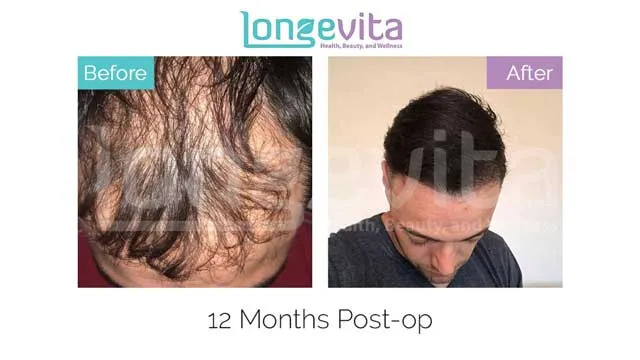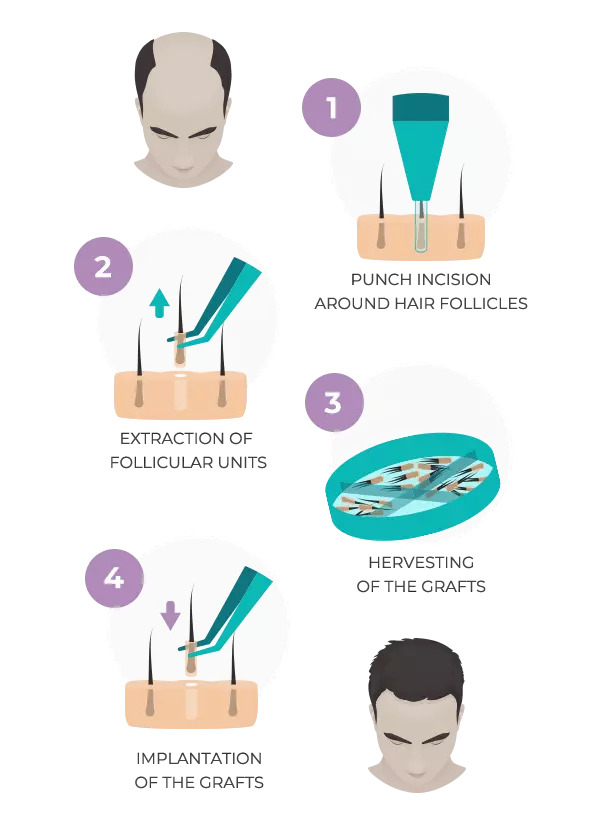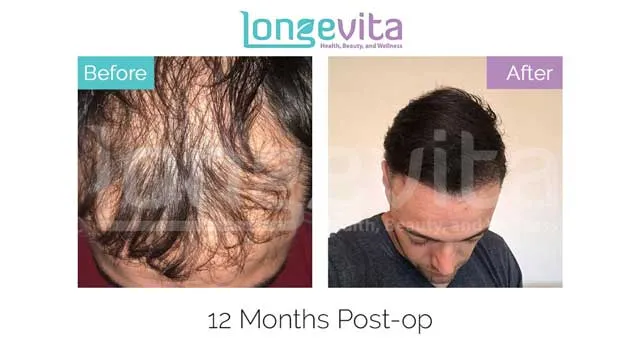If you’re experiencing permanent hair loss, you can consider follicular unit extraction or FUE hair transplant.
Through this surgery, you can achieve permanent, natural results. FUE is pain-free and does not leave visible scars.
What Is FUE Hair Transplant?
In FUE restoration surgery, the surgeon extracts individual hair grafts containing 1-4 hair from the donor area, which is the back and sides of the scalp.
After that, they make incisions in the recipient site to insert the grafts.
An FUE hair transplant takes place under local anaesthesia, so you will not feel any pain.
The surgery can last anywhere between 6-8 hours, but it can vary depending on the number of grafts you need.
If the size of the balding area is too large, you may need another FUE hair transplant 6 to 12 months after the first one.
Men’s Hair Transplant
Hair transplant for men is quite usually done using the FUE hair transplant technique.
One of the most common reasons why they seek this surgery is male pattern baldness, in which dihydrotestosterone (DHT) hormone – a byproduct of testosterone – miniaturises the hair follicles and causes balding in specific areas.
And this kind of hair loss gets worse with age. It’s a big reason behind the popularity of hair transplant surgery for men.
While there are over-the-counter medications to temporarily regrow hair, they can have serious side effects. In contrast, hair transplants for men are usually a one-time procedure, and the results last a lifetime.
It should be noted that men’s hair transplants can be very effective and successful, having a graft survival rate of 98%. But a men’s hair transplant is usually recommended after the age of 20 to ensure the best results.
As far as the cost of men hair transplants are concerned, they’re usually in the thousands. However, prices can vary significantly depending on the country where you’re getting this surgery.
Also, clinics that charge by the number of grafts can be quite expensive. If your balding area is large, you can expect to pay far more. To save there as well, you can consider looking for a place that offers the maximum number of grafts in the treatment plan.
Because you can easily get that in Turkey, and this surgery is cheaper there, it’s a popular tourist destination for men’s hair transplants.
How Much Does A FUE Hair Transplant Cost?
The FUE hair transplant cost is £1,500, which includes:
- Surgery
- PRP injections
- Accommodation at a 5-star hotel
- Private transfers
- Medication
- Translators
- Aftercare
- Lifetime warranty
Depending on the type of hair transplant FUE you choose, the price may vary.
Is An FUE Hair Transplant Permanent?
An FUE hair transplant is a permanent surgical solution to hair loss. That’s because it takes hair from the back and sides of the scalp, where follicles are unaffected by the hormone that causes hair loss (dihydrotestosterone or DHT).
Such grafts are extracted from a specific “safe donor area” so that once the hair is transplanted, you can enjoy the results for a lifetime unless you experience any hormonal issues.
Who Can Have FUE Hair Transplantation?
Many people with pattern baldness undergo FUE. Hair transplant men is usually done on the front (hairline), top, and crown/vertex of the scalp.
In females, it causes a widening of the part line, recession in the temple region, and diffuse thinning.
It is a genetic condition that makes the person lose their hair permanently.
Hair transplant procedures make use of follicles that are resistant to the effects of the hormones responsible for this genetic hair loss. This ensures permanent results.
Other than that, FUE is also suitable for those who have permanently lost their hair because of:
- Physical trauma (burn or injury)
- Traction alopecia
- Scarring alopecia
- Chemotherapy/radiotherapy
However, a suitable candidate for a hair FUE transplant needs to have a good follicular unit density in the donor region.
Am I Suitable For Hair Transplant?
What To Think About Before Getting FUE Hair Transplant
Before heading for a hair transplant in Turkey, there are a few things you need to consider.
First, ask about the surgeon who will perform your surgery. Learn about their overall experience, qualifications, and certifications.
Also, inquire about the relevant professional bodies with which they are associated, and make sure to take a look at their FUE hair transplant results.
You should also ask how long they have performed FUE transplants and whether there have been any complications.
Third, you need to know about their complication rate, transection rate, and success rate.
Lastly, ask your surgeon about the follow-up you can expect in case things go wrong. These inquiries will help you in making your final decision.

Leading hair transplantation surgeons give personalised treatment recommendations to their patients.
Your surgeon should guide you about the hair transplant method most suited for you.
How To Best Prepare For FUE Hair Transplantation Procedure
To ensure a successful hair transplant, you need to do the following things:
- Inform your surgeon about any medications that you’re taking and update them about your scalp condition.
- Stop taking any blood thinners 10 days before your hair transplant procedure.
- Do not take any recreational drugs or drink alcohol 3 days before the surgery.
- Stop smoking a week before FUE transplantation.
- Do not shave/cut your hair 2 weeks before the surgery and remove any hair system that you’re wearing 3 days before coming in.
- Do not take any supplements for a week before your hair surgery.
- Heart patients need to get written consent from their cardiologists.

How Does A FUE Hair Transplant Work?

In an FUE hair transplant, “follicular units,” each containing 1-4 hairs, are individually extracted from the back and sides of the scalp (donor areas). These grafts are then implanted into the bald spots through small incisions.
Procedure For FUE Hair Transplant
For your FUE hair transplant, the surgeon may first shave your hair. After that, they will give you local anaesthesia, which takes effect in about 5 minutes.
As a result, you won’t feel any pain or discomfort during the extraction and implantation process.
Before the extraction process, the surgeon determines the thickness of the hair, follicles per graft, and the hair type.
These factors will help them determine the number of grafts to extract to meet your aesthetic goals. The surgery itself will then take place in the following steps:
- Using a handheld, motorized punch tool (0.7-1mm in diameter), the surgeon will take the grafts out of the donor area, one by one.
- The extraction of individual follicular units containing 1-4 hair strands ensures that the hair transplant doesn’t have a “pluggy,” unnatural appearance.
- After that, using forceps, they will pick them out and place them in a solution to ensure hair follicles’ survival.
- Once the extraction is done, the hair transplant surgeon begins the insertion process. Here, they will make small incisions in the balding area and then implant the hair follicles in them.
- While doing so, they have to make sure that the angling, placement, and density of the transplanted hair are accurate so that the results look natural.
The whole surgery takes 6-8 hours. However, some patients need a large number of grafts (5,000-6,000). This may last for 12 hours.
Book A Free Consultation With Our Patient Consultants
We offer free consultations for patients across the UK & Ireland, so you can discuss your individual requirements with our specialists. Book A Free Consultation With Our Patient Consultants today.
Recovery And Results Of FUE Hair Transplant
Soon after the surgery, the hair grafts are very delicate, so make sure that you’re gentle around the area.
You will experience swelling for a few days. In addition, you may feel numbness in the surgical area a few weeks following the hair transplant.
If you feel itchy, resist the urge to scratch as it poses a risk of infection and permanent damage to the transplanted hair.
The surgery has minimal downtime. How soon you can get back to work depends on the nature of your profession.
However, it is recommended that you rest for 2-3 days right after the surgery. Other than that, here’s a brief timeline of the early stages of recovery:
14 Days After The FUE Hair Transplant
Your hair transplant scabs should have fallen off by now, and your grafts will have taken root. However, you may start to experience what’s known as “shock loss.” It’s just temporary hair loss due to the shock of the surgery that can last for 3 months.
1 Month After The FUE Hair Transplant
You may have patchy areas on your scalp due to shock hair loss, but it’s part of the recovery process. By this time, it should be okay for you to engage in physical activity.
The gym, sauna and pool might also not be a problem anymore. But you must consult your surgeon about these things first. Also, you can cut your hair 1 month after hair transplant but only using scissors.
2 Months After The FUE Hair Transplant
Again, you’re still likely to have patchy areas on your scalp 2 months after FUE. However, you’ll likely feel more normal by this point.
Keep in mind you’ll start noticing hair growth after 3-6 months. It will take around 12-18 months before you see the final results.
Aftercare Of FUE Hair Transplant
In order to reduce swelling after hair transplantation, lie down with your head elevated.
You can start scalp massages 2 weeks post-op as it can help get rid of scabs while improving blood circulation.
Avoid any activity that makes you sweat, such as exercising, sauna, and hot baths, for at least a month after your hair transplant.
Moreover, you cannot enter the pool or go under direct sunlight for a month post-surgery.
For washing your head, use the medicated shampoo and lotion according to the surgeon’s instructions.
Make sure the water pressure is not high as it can dislodge the grafts, and the water should neither be too hot nor too cold.
Also, avoid tight headwear for a month after the surgery. In addition, stay hydrated and eat healthy for normal recovery.
Side Effects to Expect After FUE Transplant
The side effects of this surgery are usually temporary. You may experience the following:
- Swelling
- Pain/Discomfort
- Bleeding
- Numbness
- Itchiness
- Infection
- Folliculitis
What Could Go Wrong with FUE Hair Transplant?
You may develop a scalp infection in the recipient area, which can damage the transplanted grafts and alter hair growth.
Consequently, it will affect the overall hair density in the final outcome. Moreover, it carries a risk of scarring.
Make sure that you follow the aftercare instructions that the surgeon provides.
What To Do If You Have Any Problems with FUE Hair Transplant
In case a problem arises after a FUE hair transplant, you can avail of free online aftercare services.
Alternatively, you can get an assessment from your surgeon after emailing or calling the Aftercare department for assistance.
Alternatives to FUE Hair Transplant Procedure
If the patient has a weak donor area with extensive balding, they might not be eligible for hair transplant surgery.
In this case, they can discuss the option of taking oral/topical medication for thinning hair. Other than that, they can consider scalp micropigmentation, which will give the appearance of a fresh buzz cut.
Other Procedures to Have with FUE Transplant
When getting an FUE hair restoration surgery, you can also get platelet-rich plasma (PRP) therapy. It can speed up the recovery process while ensuring a greater survival rate for transplanted grafts.
Moreover, this improves overall hair density. The patient can start getting PRP injections on the day of the surgery.
Best FUE Hair Transplant Clinic
For over 10 years, Longevita has served more than 15,000 patients with a success rate of 98%. Our specialized treatments have helped people permanently deal with hair loss and baldness.
It’s been made possible because we work with a team of highly-qualified medical professionals who embrace the core values of the International Society of Hair Restoration Surgery (ISHRS) and the British Association of Hair Restoration Surgery (BAHRS).
Examining the FUE hair transplant before and after photos will give you a better idea of the surgeons’ skill level.
Additionally, your hair transplant will be performed in a facility which is registered with the Ministry of Health.
Rest assured, we do everything to ensure the highest level of safety and care so you can get the best FUE hair transplant.
| Surgical Technique | Individual follicular units (containing 1-4 hairs) are extracted using a punch tool and transplanted to the bald areas |
| Candidates | Genetic hair loss, trauma-induced hair loss, chemo- and radiation-induced alopecia, & scarring alopecia |
| Surgery Time | 6-8 hours |
| Anaesthesia | Local anaesthesia/sedation |
| Cost | £1,500 (including additional services) |
| Longevity | Permanent |
| Recovery | 2-3 days |
| Washing | 2 days post-op |
| Results | After 12-18 months |
| Best Age | 20 and above |
| Duration of Stay | 2 days (check-up takes 1 day) |
| Side Effects | Swelling, bleeding, numbness, pain, pimples, itchiness, discomfort and shock loss |
FAQ
What's the difference between FUE and FUT hair transplants?
In a FUT hair transplant, the surgeon removes a strip of skin from the back of the head and extracts follicular units from it. However, in FUE, the surgeon directly extracts follicular units from the donor area.
Is FUE scarless?
FUE hair transplant scars should fade with time and are barely visible even with short haircuts. That said, it does leave behind punctiform scars that are less than a millimetre in diameter.
What makes a donor area "weak" in an FUE hair transplant?
A weak donor area means that you have 15-20 hair grafts per cm2 on the back/sides of your scalp. You may not be able to get a hair transplant in this case.
What is the graft survival rate after FUE hair restoration?
The hair graft survival rate in FUE restoration surgery is around 95%.
Can I lose hair after an FUE transplant?
You can experience temporary hair loss after the surgery, but the transplanted grafts remain permanently intact.
Do I have to shave my head for an FUE hair transplant?
Your surgeon may recommend shaving the head prior to surgery for greater visibility. However, you can also get a hair transplant without shaving your head.
At what age can I get an FUE hair transplant?
It is recommended that you wait to get FUE till the age of 20 and above if you have male pattern baldness. Female pattern hair loss usually sets after menopause. For other conditions, you should consult a doctor.
How many hair grafts do I need for an FUE?
That depends on the balding area. You can find out the number of grafts you need using a graft calculator.
Will I meet my FUE hair transplant surgeon to agree to the treatment plan prior to the day of surgery?
Yes, you will have a face-to-face consultation with your hair transplant surgeon before the surgery. In it, you should communicate your expectations from the procedure, and the surgeon will inform you what’s achievable.
Moreover, they will explain the surgical procedure and draw your hairline. They will only proceed with the surgery once you agree to the treatment plan and hairline design.
Who is the FUE hair transplant surgeon, what are their qualifications and experience, and where can I verify this?
Our team will share the CV and portfolio of the surgeon with you. Moreover, you can learn more about them on our related page.
Which parts of the FUE hair transplant will be done by a doctor and which by a non-doctor?
A team of 3-4 medical practitioners will perform the FUE transplant. Your hair transplant surgeon will make the incisions in the recipient site before the insertion of the hair grafts.
Is the hair transplant clinic registered with a health care authority?
The clinic for FUE hair transplants in Turkey is registered with the Ministry of Health.
Does my hair transplant surgeon have insurance that covers my procedure?
Your hair transplant surgeon will have malpractice insurance.
How long will I need to stay abroad after FUE hair transplant before I’m well enough to travel back to the UK?
You can return to the UK a day after the FUE hair transplant. However, we recommend you come for your follow-up appointment the very next day.
Will follow-up checks for FUE be offered in the UK?
Other than online aftercare services, you can get an in-person medical assessment in the London clinic.
Can you put me in touch with anyone else who has had an FUE hair transplant?
If you request it, we can put you in touch with someone who has had an FUE from your surgeon.
What language will the doctors, nurses and other health workers involved in my FUE surgery use and what language will my medical notes be in?
It will all be in English. To further assist you, an interpreter will also accompany you.
Is it possible to undergo FUE after FUT hair transplantation?
You can undergo an FUE after having FUT surgery. The latter leaves a linear scar, and it can cause aesthetic concerns if the patient needs another session to cover a large balding area.
Therefore, they can opt for FUE instead, which can be performed successfully without leaving visible scarring. FUE can also be done to hide a FUT scar.
Reviewed and Approved by Trichologist Yaprak Yazan.



